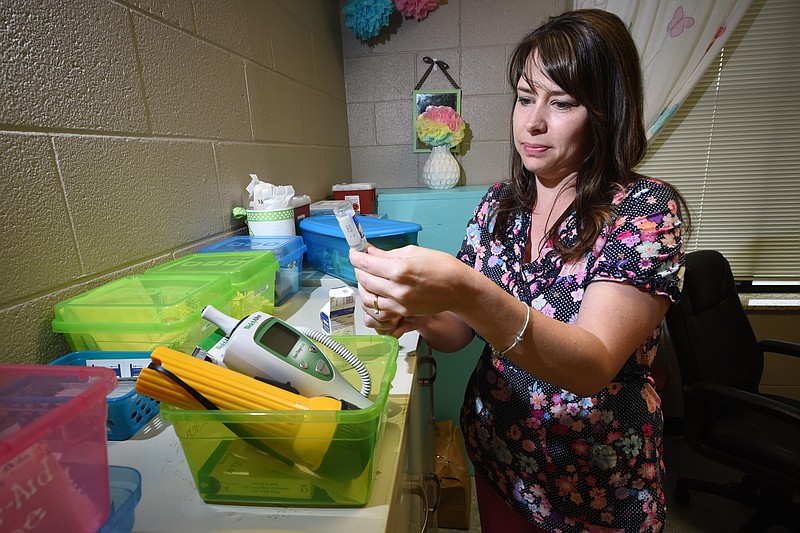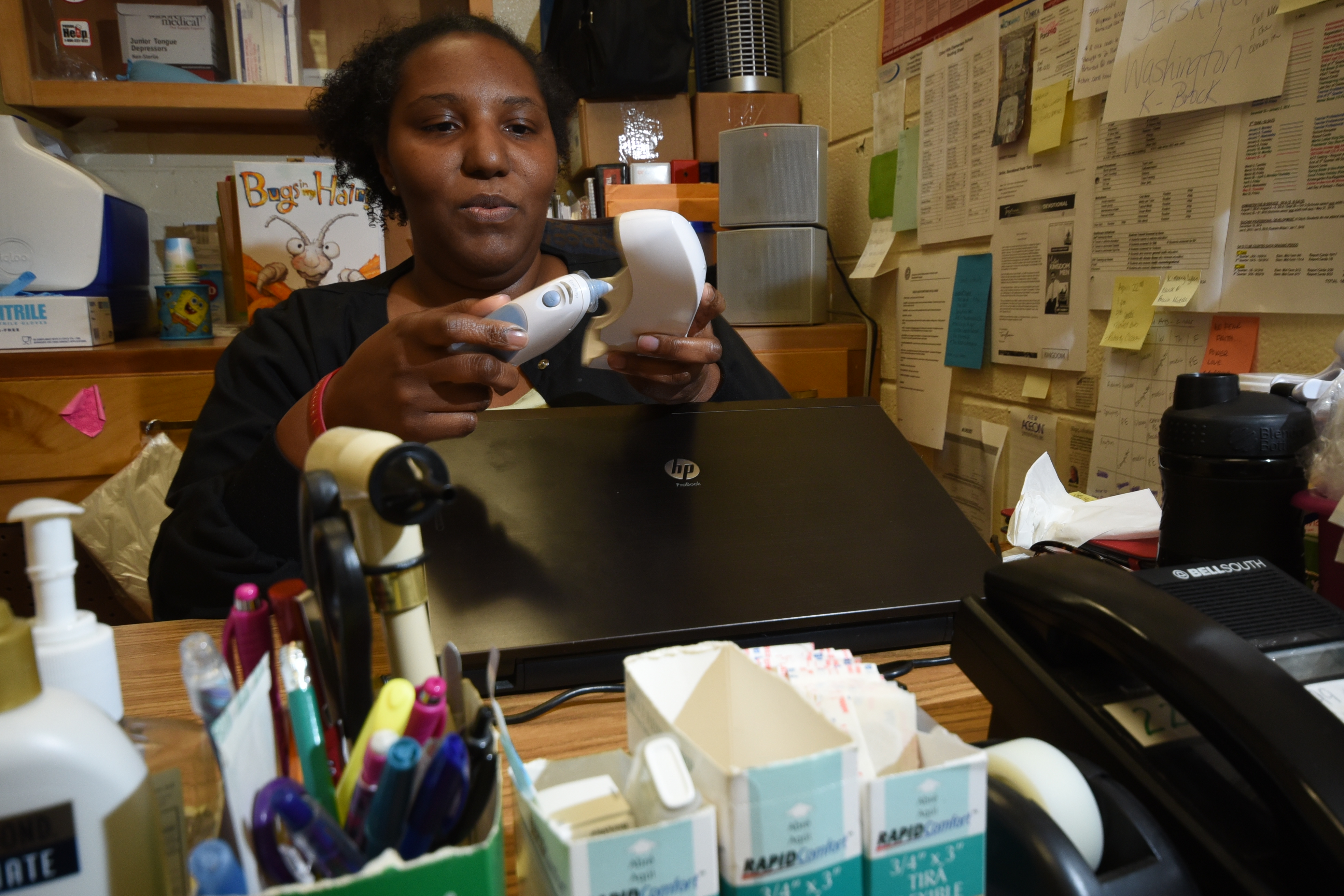HEALTH CONDITIONS IN HAMILTON COUNTY SCHOOLS
Below are the end-of-year statistics showing the number of Hamilton County students with chronic illnesses or disabilities, drawn from 2014 Health Survey, out of approximately 42,000 students. Asthma -- 3,595 Severe allergies -- 1,222 ADD/ADHD -- 992 Intellectual disabilities -- 778 Autism -- 628 Mental health* -- 90 Diabetes -- 136 Seizure Disorder -- 257 Other** -- 349 Total Number of students with chronic illness or disability -- 8047 * Depression, anxiety disorder, obsessive-compulsive disorder ** Cerebral palsy, sickle cell, cystic fibrosis, spina bifida, etc. Source: Hamilton County Schools FLUCTUATING NURSE NUMBERS Over the last eight years, the number of nurses in Tennessee public schools has fluctuated, growing by more than 500 in one year, and dropping by nearly 600 two years later. The number is now closer to the median. 2006-07 -- 1,084 2007-08 -- 1,632 2008-09 -- 1,473 2009-10 -- 1,043 2010-11 -- 1,476 2011-12 -- 1,345 2012-13 -- 1,369 2013-14 -- 1,365 Source: Tennessee Department of Education LOCAL SCHOOL NURSE GAINS The following numbers show the number of nurse positions area schools have added between 2004 and 2014. Bledsoe -- 2 Bradley -- 11 Grundy -- 5 Hamilton -- 40 Marion -- 2 Meigs -- 2 Rhea -- 3 Sequatchie -- 1 Source: Tennessee Department of Health
As early as 5 a.m. on weekday mornings, Sheryl Rogers' phone begins humming with calls and emails. A school nurse is out sick. A replacement needs to be at the school by 8 a.m. to help administer diabetes medication to students there.
It's time for Rogers, the coordinator of health services at Hamilton County Schools, to consult "the mainframe." That's her nickname for the elaborate chart that lists every single chronic health condition found among Hamilton County students, from asthma to ADHD to nut allergies.
Rogers' color-coded chart helps her know where nurses need to be on any day to provide medication, to be on call for seizure disorders or to help with tube-feeding or catheters.
By the time school starts, all the nurses need to be matched to the day's needs.
"It's like staffing a hospital floor," she said. "We have to do what's necessary to keep these kids in school."
Nineteen years ago, just six school nurses served all of Hamilton County's 80-plus schools. Today, a squadron of 69 full-time health personnel serves on the front lines of a swiftly changing health-care landscape: Growing rates of obesity, diabetes, and learning disabilities; more students with physical disabilities able to attend traditional public schools, and new protocols for a range of disasters, from school shootings or terrorism to tornadoes.
"For school nurses, the early expectation was that we mothered, Band-Aided and soothed," said Rogers. "It's a different world, post-9/11, post-school shootings. ... The role of the school nurse has evolved."
As the demands have increased, resources have not always followed. National advocacy groups have for years decried a shortage of school nurses -- the National Association of School Nurses says fewer than half of public schools in the United States now have a nurse on staff.
But in Hamilton County, efforts are underway to widen the scope of school-based medical care, especially for children in high-risk neighborhoods facing more dire rates of health problems.
School officials, partnering with local advocacy groups, say they hope to have small primary care clinics set up in schools throughout the district within two years -- and may have the first one up and running by next spring, likely managed by local community-care practices.
"If you look at populations with higher social risk factors, the logistics of delivering primary care can be tremendous," said Dr. Allen Coffman, a local pediatrician who is president of the Pediatric Health Improvement Coalition of the Tennessee Valley -- the group pushing for school-based clinics. "If you can move the care to where the child is going to show up every day, you remove a lot of those logistical problems."
Catoosa County, Ga., is already tracking the benefits of a school-based clinic that was set up two years ago at Tiger Creek Elementary School in rural Tunnel Hill, Ga., with the Emory University Pediatric Urban Health Program.
The center serves Catoosa County schools students and their families, with sliding-scale fees for the uninsured. The clinic began including dental services last fall, and this year it will be open through this summer for the first time.
"We're already seeing absences reduced," said Sandy Matheson, spokeswoman for Primary Health Care Centers, which runs the Tiger Care Clinic. "You have kids getting this overdue treatment, like one young man who never even knew he had asthma. Instead of leaving school all the time, he goes and gets his nebulizer treatment and he's back in class."
* * *
The quest for more school nurses in Hamilton County began two decades ago, when ER doctors at the T.C. Thompson Children's Hospital at Erlanger noticed alarming numbers of kids coming in with preventable illnesses: Whooping cough. Asthma. Diabetes complications.
Next year, the county has budgeted $2.7 million for health services, which largely pays for nurse salaries.
But nurses still see major health disparities in certain communities.
"It can be shocking to see just how wide the health divide is in Chattanooga," said Coffman. "So many parents do not realize the tremendous gaps in care we see."
The pediatric health coalition has been meeting with parent groups from East Chattanooga, Southside and Alton Park neighborhoods, and with parents of children with special health needs, to glean their ideas about school health programs. The school-based clinics are at the cornerstone of that vision.
Many parents from inner-city as well as rural neighborhoods face large obstacles, from getting off work to transportation to the doctor.
"We've had parents who used to miss a whole day of work to get their kids to the doctor," said Matheson. "And they would have to take the sibling out of class, too."
School-based clinics are designed to close those gaps. They offer regular checkups and dental care, along with more urgent-care services. Many offer mental health counselors.
There are about 1,900 such clinics nationwide, including a growing number in Georgia under the Emory-led efforts.
"Our primary goal has always been to increase access to health care in many of our underserved areas," said Dr. Veda Johnson, who oversees the Emory program's Georgia expansion efforts.
"The movement has really begun to pick up steam," she said. "We're going to give out another four grants this year. People understand the need for a model like this."
In Chattanooga, the goal is for foundations to underwrite the cost of starting the clinics. Once they are up and running, they are largely self-sustaining, since many children are covered under TennCare.
School officials have been "tremendously supportive" of the idea, said Coffman.
"We've got parents who work two jobs a day and don't have time for the doctor," said Lee McDade, assistant superintendent of the Hamilton County Department of Education. "If we can make this care more accessible, then it's a win-win for everyone."
Including the school nurses, Rogers says. Even if clinics were established, advocates say, the need for school nurses would be just as strong as ever.
"Nurses are at the core of these programs," said Johnson. "They are the ones who know the children, and develop trust. They are the gateway."
Contact staff writer Kate Belz at kbelz@timesfreepress.com or 423-757-6673.

